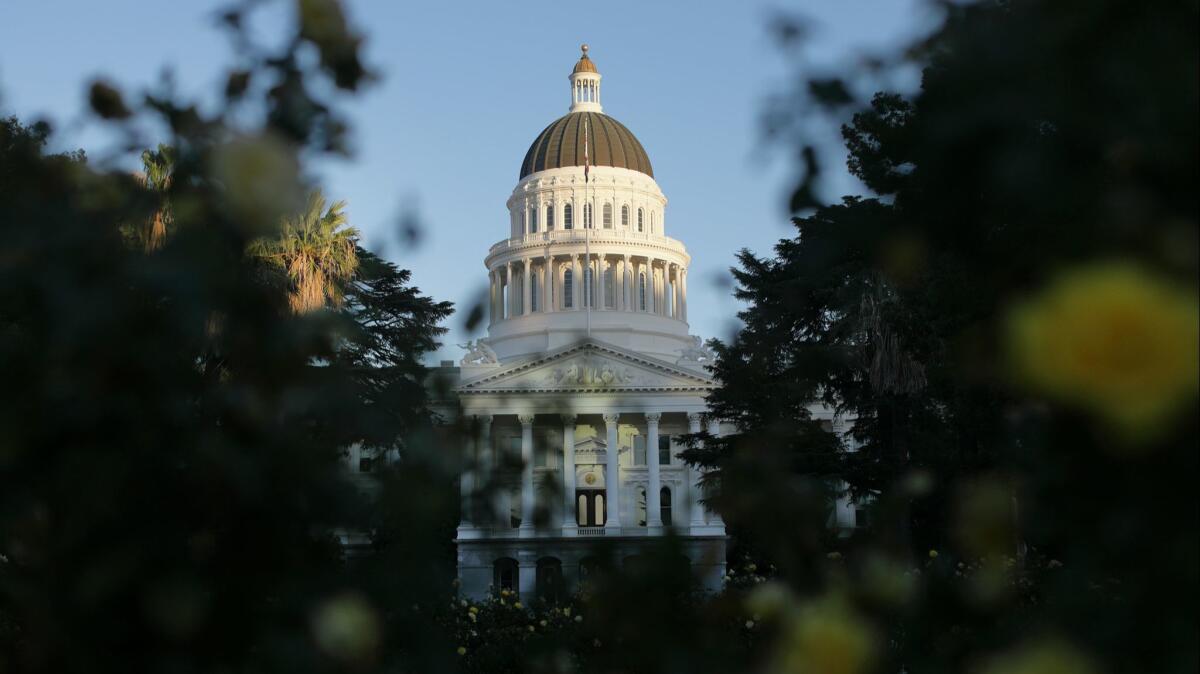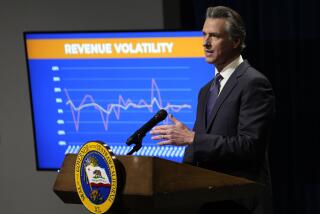California lawmakers approve a state budget blueprint, but negotiations continue

- Share via
Reporting from Sacramento — Democrats in the California Legislature sent Gov. Gavin Newsom legislation Thursday that lays out the blueprint of a $214.8-billion state budget, a plan that assumes significant new spending on K-12 schools and healthcare while setting aside an unprecedented amount of tax revenue for future economic slowdowns.
But work on the state budget remains ongoing as Newsom and lawmakers continue to privately negotiate over a closely watched effort to change California tax law — one that is essential to the governor’s plan to expand a tax credit for the state’s lowest earners.
“I am confident in these ongoing negotiations,” state Sen. Holly Mitchell (D-Los Angeles) told her colleagues during debate on the overarching budget bill.
The negotiations, though, have proved difficult. Most significant is an effort to bring in $1.7 billion in revenue by rewriting state tax law to more closely conform to changes made in 2017 to federal rules. The money is key to Newsom’s signature effort to triple the size of California’s tax credit for those with the lowest annual incomes.
Because the proposal would result in a tax increase on some state filers, it requires a two-thirds vote in each legislative house — and there’s been significant resistance among some Assembly Democrats. Even so, the primary budget bill approved Thursday includes an assumption that tax revenue will materialize. If lawmakers fail to sign on, it could present significant challenges to the budget’s financial architecture, most notably in the way funding is allocated to K-12 schools and community colleges.
Action on additional budget-related bills must occur before the state’s new fiscal year begins July 1. Thursday’s party-line votes in the state Senate and Assembly, however, were enough to meet the Saturday constitutional deadline for approving a primary budget plan — failure to do so would have led to lawmakers’ paychecks being withheld.
Democrats praised the plan, including many of the provisions contained in bills to be considered next week, and insisted that a significant amount of new spending is prudently structured to expire after two years and therefore won’t saddle the state with mandated costs in the event of a recession. The approach was championed by Newsom in his own budget proposal and employed in expanding programs designed to help low-income families.
Remember when California’s budget was always late? Those days are gone »
Most notably, California’s new budget includes a sizable effort to expand access to healthcare — a combination of larger subsidies for purchasing insurance and a first-in-the-nation promise to provide government-subsidized Medi-Cal coverage to low-income residents up to the age of 25, regardless of their immigration status.
The subsidies, available through the Covered California health exchange at a three-year cost of some $450 million, would be available to a family of four with an annual income up to $150,600. For those just barely above federal poverty guidelines, the budget sets aside enough money to cover the full cost of healthcare premiums.
Those subsidies will be funded by penalties imposed on Californians who don’t purchase health insurance, a state-run version of the individual mandate that was a key component of the federal Affordable Care Act. President Trump and congressional Republicans eliminated the law’s tax penalties in 2017.
While bringing young adults in the U.S. illegally into the Medi-Cal program might generate the most public attention — the governor’s administration estimates it will add some 90,000 people to the program in the new fiscal year — lawmakers also agreed to reverse a number of healthcare cuts made during the Great Recession a decade ago. Medi-Cal recipients will again have access under the budget to care considered optional, including vision, hearing, podiatry and speech therapy services.
Critics, though, said that the budget doesn’t do enough to ensure doctors will take Medi-Cal patients. Reimbursement rates paid by the program remain low.
“We had an opportunity to fix that in this budget, and we’re not doing it,” Assemblyman Jay Obernolte (R-Big Bear Lake) said.
Once signed into law, the budget will set aside money for an additional 11,000 children to receive subsidized child care and 10,000 new full-day slots for preschool services. Some of that will be earmarked for working families and children in low-income communities. The budget also provides new money to avoid disruptions in child care for families enrolled in the state’s CalWorks welfare assistance program.
Newsom and lawmakers agreed to spend $195 million for training child-care workers and another $300 million on building new school facilities for full-day kindergarten. The plan also allocated $645 million for improved special education efforts, with much of that money going to services for children as young as 3.
The budget sets aside money to expand fee waivers for students in their second year of community college and expands enrollment on University of California and California State University campuses. It also adds enough funding to the competitive Cal Grant program to provide scholarships to as many as 41,000 students a year.
“We have to invest in Californians who have a hard time paying for school,” Assemblyman Phil Ting (D-San Francisco) said.
Lawmakers agreed to take action on providing clean drinking water to communities with contaminated supplies.
“There’s not one person in California who should live that way today,” Senate President Pro Tem Toni Atkins (D-San Diego) said.
The effort would be funded largely through revenue collected from California’s cap-and-trade climate program, which requires some companies to purchase greenhouse gas emissions allowances. Totaled up over the next decade, the project could provide more than $1.3 billion for new drinking water supplies — while avoiding Newsom’s original, but politically difficult, effort to pay for the plan through a new statewide tax on water rates.
But other potential stumbling blocks remain, including the creation of a new telephone service tax to fund 911 operations. That effort has failed before, but supporters say last summer’s deadly wildfires may have placed enough attention on the system’s shortcomings to change the legislative outcome next week.
Lawmakers also continue to haggle over the details of how to allocate $650 million in local government grants to address the state’s homelessness crisis.
For much of the last few decades, such disagreements would have stalled the entire budget process deep into the summer, threatening the state’s ability to pay for services. But in the years since voters changed the rules — a 2010 statewide ballot measure allowed legislative passage by a simple majority in each house — budget action has typically been fragmented. Lawmakers often work on the budget beyond the June 15 deadline, taking action on enough of a spending plan to avoid the perception that they’ve been delinquent in their duties.
Follow @johnmyers on Twitter and sign up for our daily Essential Politics newsletter
More to Read
Get the L.A. Times Politics newsletter
Deeply reported insights into legislation, politics and policy from Sacramento, Washington and beyond. In your inbox twice per week.
You may occasionally receive promotional content from the Los Angeles Times.











